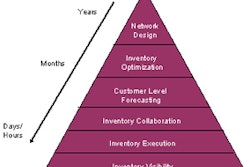By Tejas Faldu and Srikanth Krishna
With rapidly increasing competition and changing market forces, supply chain performance management (SCPM) is a critical area for consumer packaged goods (CPG) companies to help sustain and gain competitive advantage in the CPG space by enabling an agile, lean and efficient customer-oriented supply chain. A robust SCPM infrastructure is crucial to realizing the benefits of various collaborative initiatives.
However, CPG companies need to address key issues before making significant investments in SCPM initiatives. Management must ensure enterprise-wide awareness and understanding of strategic and financial objectives along with the financial impact of supply chain performance on overall corporate performance. Processes and roles in the supply chain need to be mapped to key metrics to determine performance. There must also be a mechanism in place to periodically review actual supply chain performance and redefine performance measures in the changing business context. Further, an integrated single view of supply chain performance across functions and hierarchies is essential to help senior management quickly determine the causes of supply chain failures.
This article offers a step-by-step guide to defining, building and leveraging an effective "metrics framework" that can turn supply chain performance management into a potent tool.
Developing the Framework
A balanced set of metrics, aligned to various supply chain functional areas — demand planning, customer management, warehouse management, etc. — needs to be identified to address decision-making requirements. These metrics should be mapped to the processes of each supply chain function, the overall business strategy and the roles responsible for executing these processes.
1. Establish the right metrics
When choosing a specific set of metrics, a company must consider the four basic characteristics that make metrics effective: reliability, validity, accessibility and relevance.
- Reliability refers to the consistency of the metric used to measure a given process. As long as the circumstances governing the process do not change, the metric should return a fairly consistent value.
- A valid metric is one that measures the concept in a specific business context.
- Further, for metrics to count, they must be easily accessible, i.e., retrieved with reasonable effort and cost.
- Finally, metrics need to be relevant so that the functions or people concerned can relate to the information and make intelligent and proactive decisions.
2. Link metrics to overall strategic objectives
To tie metrics to the larger strategic goals, it is important to determine the strategic objectives to be used to evaluate the supply chain (e.g. customer satisfaction, enterprise profitability, etc.). This must be followed by building a related supply chain metrics hierarchy under each of these strategic objectives. The hierarchy starts with high-level metrics — suggestive of the overall health of the supply chain — and moves to mid-level and lower-level metrics that are more tactical or operational in nature.
3. Create a detailed metrics bank
Building a detailed metrics bank entails a multi-step process to create an exhaustive set of related metrics that associates metrics with each supply chain process and maps the metric to the role that is directly accountable and responsible for its measurement and performance. In addition to identifying the class of the metric based on the information and process health insight it conveys, it is important to build high-level interdependencies of metrics based on common knowledge and understanding of basic processes. The process must also identify the various dimensions to enable a comprehensive view of the metric in addition to determining how metrics will need to be computed. Further, the process needs to determine the frequency at which the metrics will be measured — this will also be governed by the granularity of available data and the cost-benefits associated with a certain measurement frequency.
Leveraging the Framework
Once a strong metrics framework is in place, it is critical to understand how it can be leveraged to enhance supply chain performance.
1. Generate insights using cause-and-effect guided analysis
A metrics framework is a collection of relevant metrics. These metrics are interrelated to establish a cause-and-effect relationship that helps to determine the root causes of failure of various business processes.
To illustrate this, let us focus on "product availability at shelf" as an effect and start building a metrics framework. (See Figure 1.) The end objective here is to ensure product availability at the shelf.
The framework clearly highlights the need to collect important metrics such as forecast accuracy, order fulfillment times, manufacturing schedule adherence, etc. In the absence of a good framework, having data regarding "product availability at shelf" but not the related metrics would severely limit the constructive use of the end-result data. A word of caution: Every metrics framework is unique. Each enterprise is expected to have a metrics framework that is unique in terms of number and the types of causes as well as the hierarchy and criticality of causes to the end-effect. However, some key points must be considered when defining the metrics framework.
First, while no metrics framework is likely to identify all relevant variables, enterprises must make a conscious effort to build a metrics model that is comprehensive enough for their business context. This can be best achieved by deploying a cross-functional team with a strong understanding of underlying processes and responsibility for process execution. Top management sponsorship is also critical to ensure that the metrics framework identified by the cross-functional team is aligned with the overall enterprise objectives.
Another factor to look out for is an element of judgment and approximation. Given this, there should be a focused effort to identify the most relevant and high-impact causes. Like the metrics that make them, metrics frameworks tend to be highly contextual in nature. They are dependent on the team developing them for knowledge, goals for measurement and the vision for how the SCPM system should integrate with the overall enterprise performance management objectives. Besides people, data availability, accuracy, etc. are other factors that must be considered. These are additional constraints in designing the metrics framework.
Above all, the metrics framework cannot be static and needs to be continuously refined to align with enterprise objectives. For example, as the enterprise IT landscape changes, metrics ignored earlier for lack of data availability may need to be accommodated to make the framework more robust and relevant.
2. Quantify financial impact of supply chain metrics
This process is used to link supply chain metrics to financial key performance indicators (KPIs). For example, a cash-to-cash cycle time metrics framework should be linked to return on assets, a total supply chain cost metrics framework should be linked to net margin through cost of goods sold (COGS), and so on. It is important to establish the link with financial measures because this helps senior management quantify the performance of supply chain metrics and better understand the supply chain's full impact on the enterprise's top and bottom lines. This "linking" is done through scorecards. Enterprises use these scorecards to determine priorities for investments in improving processes and related technology. Such scorecards help establish a standardized "single version of truth" for supply chain performance that is quantifiable and understood by all entities in the organization.
3. Review the supply chain scorecard in the sales and operations planning (S&OP) process
While metrics reflect the overall health of the supply chain and various functions, they need to be supported with process mechanisms. These mechanisms enable a joint review and formalization of corrective plans from a cross-functional perspective.
Among the best practices for implementing effective sales and operations planning (S&OP) processes is establishing pre-scheduled meetings — with a well-defined agenda — with critical players in the supply chain, along with their cross-functional teams.
Another key requirement to enable an effective S&OP is to have the IT capability to aggregate and structure enormous supply chain information and data originating from disparate IT systems. This facilitates a clear and comprehensive view of the supply chain. And finally, it is vital to benchmark supply chain performance with best-in-class companies in your own industry, as well as across industries.
Benefits of the Metrics Framework
The supply chain performance management framework is a powerful tool for enterprises to build efficient, responsive and agile supply chains that are managed and led by committed and well-informed managers and executives within the enterprise as well as partners. When executed effectively, the metrics framework can lead to significant benefits for a company.
1. Alignment of supply chain metrics to overall corporate metrics and strategic objectives
There are instances of supply chain performance being driven by KPIs that do not accurately reflect what it would take for a CPG company to win in the marketplace. For example, if the primary KPI of a supply chain is to optimize on inventory turns, it could become overly focused on reducing inventory levels at all nodes of the supply chain. The result could be that either service levels or lead times could get compromised, resulting in a much more significant impact on corporate performance in the long run. The top-down approach recommended in this article helps derive and align supply chain KPIs to key corporate objectives like customer satisfaction, financial performance or operational excellence.
2. Enhanced collaboration internally as well as with external business partners
A supply chain metrics framework that is meaningfully aligned to corporate goals and is suitably supported by cause-and-effect guided analysis enables internal business functions like sales, marketing, manufacturing, etc., as well as business partners like suppliers, third-party logistics providers, etc., to clearly understand their role in shaping the success of the CPG supply chain. This in turn improves the performance of both the company and its extended enterprise. Such an understanding also helps eliminate functional silos, creating a results-oriented, multi-functional, multi-partner team that is able to visualize and work towards a larger objective instead of focusing on individual or functional delivery.
3. Increase in employee productivity at all levels
Automated and timely customized scorecards consisting of metrics relevant for each role/function/process within the supply chain significantly reduce time spent on data collection and collation. This "reclaimed" time can now be fruitfully spent on root cause analysis and making and executing well-timed decisions supported by reliable and accurate data.
4. Greater commitment and ownership of metrics and targets
Many organizations establish supply chain metrics and their targets without ensuring an adequate feedback mechanism prior to finalization of metrics and targets from the owners of these metrics. This fails to create adequate ownership and a common shared objective. On the other hand, an S&OP-driven process that ensures collaboration and consensus on metrics and target-setting helps create greater commitment and objectivity in performance. To maximize the benefits of SCPM, such a framework needs to be supported by adequate review processes and an organizational climate that fosters collaboration and teamwork.
According to AMR Research, supply chain organizations of large enterprises have on average more than 300 employees across business divisions and geographies. Building and leveraging the supply chain performance management framework to improve their productivity, ensuring greater collaboration internally and externally, and being able to provide visibility of their performance in the context of the overall corporate performance can create significant competitive advantage. With increasing focus on creating supply chain excellence, the supply chain performance management framework is an investment that can provide healthy returns in the long run.
About the Authors: Tejas Faldu is a senior consultant with Infosys' Retail and CPG practice. He can be reached at [email protected]. Srikanth Krishna is a senior project manager with Infosys' Retail and CPG practice. He can be reached at [email protected].



















